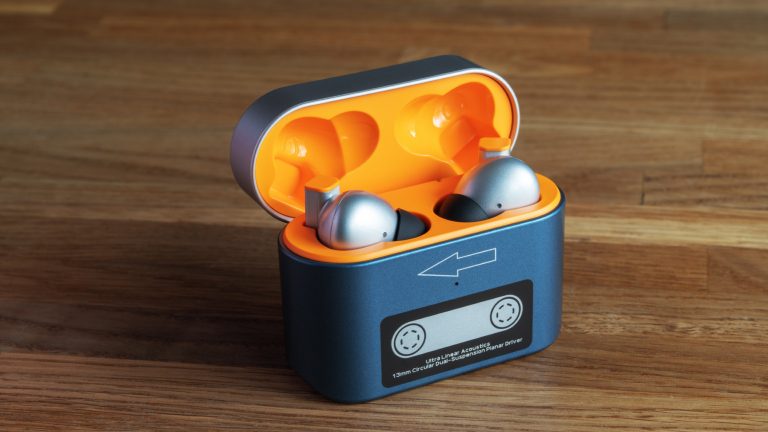Top In-Ears (Ranking)
I’ll start by telling about the goals, approaches and additional considerations that motivated me during the creation of the measurement database and the earphones rating, and then we’ll move on to the name of the game — what kind of in-ears and for what money one should and shouldn’t buy.
The most impatient readers can go straight to point 7.
1. Why do we need another measurement database?
Well, firstly, it’s not just ‘another measurement database’ — this one is at squig.link because it allows you to compare frequency responses of headphones quickly. Secondly, I don’t trust other people’s measurements because I don’t understand how they are made.
Let’s compare the measurements of the same headphones on different ‘squigs’ (by applying Photoshop because we can’t do it directly).
Here is Chu 2:

This is DaVinci (aligned with a linear shift at 500 Hz; the scale of all graphs is the same):

This is Arya:

And why do we need databases? Well, let’s say, a knowledgeable user would enter them and roughly evaluate the sound of headphones. And how should they evaluate it with such a spread? As a user, what ‘squig’ should I trust? Someone states what rig was used for measurements, but usually this information is not available. What eartips were used is not specified in 99% of cases either. That is, these graphs work only within the framework of their ‘squigs’ and only with the reviewers’ explanations, in the strict sense. Heaven only knows which one of them is true to life.
Thus, as a user, I can’t make a decision about buying certain headphones by looking at these measurements, and, as a reviewer, I can’t compare my measurements with others’ because other measurers don’t provide additional information about how they make measurements. This information is probably available somewhere, but it’s aside.
Besides, there are very few people who measure different specimens of the same models so that they can say at least anything about their variability (hi, ZiiGaat!).
2. What I’ve done
“I need to do it myself and in a big way!”, I decided, as always.
My measurements at https://boizoff.squig.link / do not have a number of the above disadvantages:
- I state directly what I use for measuring;
- for 90% of the measured models, I have stated specific models of eartips;
- for a number of headphones, there are measurements of several specimens;
- for 90% of headphones, there is a check mark near one of the measurements.
I need to explain the last point expressly: if you take in-ears such as, for instance, 7Hz G1, put original silicone eartips on them and shove them into the auditory canal simulator, you’ll get this:

Excellent! Harman with subbass and a very neat, slightly cleared-up middle, just a miracle. Isn’t it a gift for $30?!
Then you put them in your ears, turn on the music and… turn it off right away because the G1 sound has an incredibly sharp top section scratching your ear. And it would seem that there’s nothing alike on the graph. How come?
The point is that the rig measurements depend on the distance and volume of air left between the measuring microphone and the sound duct of the earphone. You can take some eartips and shove the earphone quite deep, or you can take some other eartips and make a measurement in a position where the earphone is about to fall out of the simulator. Yes, everyone is trying to get into the resonance at 8kHz, but different eartips displace different volumes of air from the sound ducts of the rig. In other words, the peak, be it large or small, will be measured, but the area from about 2 to 20 kHz will look different.
And here we come to the main question: HOW WILL A LIVING PERSON HEAR THESE HEADPHONES? Yes, there is variability in the channels (and here it’s important not to confuse variations in auricle structures with ones in the volumes/lengths of auditory canals of different people; the former are much larger than the latter), but, at least approximately, HOW?
That’s why I came up with the following: I need not just to measure headphones, not just to mention eartips, but to mark measurements that reflect real auditory experience first-hand. For this, I need to take a sine generator, listen carefully to the sine in headphones at different frequencies, and then correlate it with different versions of my own measurements and choose the one that is most similar.
And then I mark it. Let’s go back to the example:

This measurement reflects real perception of the 7Hz G1 sound, so it’s checkmarked. And this is a terrible sound – look at Everest at about 11 kHz: it’s 12 dB high, that is, 4 times louder.
But it’s honest.
And what if we take any other eartips?!
If we take some other eartips and move the earphones here and there on the rig, the measurements will be different. The thing is that, however, it’s possible to twist the foam of the eartip tighter and push it up when putting the earphone into the rig, but you can’t do the same with a live ear. That is, I go by the sound that is obtained with an earphone comfortably sitting in my ear. Some 10 years ago, the in-ear enclosures used to be small (compared to today’s models), and the sound ducts used to be thin. This provided for a real fit variability. Today’s models have relatively thick sound ducts, 5.5-6.5 mm in diameter, as well as ergonomic enclosures that roughly follow the shape of an average auricle, which means that the earphone design greatly limits the variability of its placement in the ear: the enclosure itself will not let you shove it deeper and bump into the auricle, but when you don’t insert the earphone to the end, it will just pop out. And there is no difference whether it’s a foam or a silicone plug – it will sit exactly the same way, at the same depth in a ‘live’ ear. However, in order to simulate such a realistic fit during measurements, I may need some eartips other than the regular ones, for example, KZ foam tips, SoFoam or something else.
(Anticipating a question about Etymotic earphones, yes, Etymotic headphones do exist. I know about them, and they are practically the only ones that are so unique.)
To sum it up, the information about the eartips is addressed not to the user, but to another measurer so that they can reproduce the conditions of my measurements at their rig (if the rig is of the same standard) and make a comparison (yes, all my measurements can be downloaded). But the check mark is all good for users, listeners, and potential buyers who want to understand what kind of sound they will actually receive.
It’s clear that you won’t hear exactly the same thing as me, but it’ll be very close to it.
And yes, I’ve tested it on the living. It works.
3. Measurement database capacity
In-ear headphones are released at a rate of several new models per day. It’s simply impossible to measure everything physically. Therefore, within a week I’ve figured out the current models, reviewed thousands of reviews, feedback and graphs (quite literally), and then just bought the most interesting ones. A number of them (a large number, I should say, more than 25 models) was provided by Sergey Gudkov, to whom I say many thanks again and again. I bought some 40 models. I took measurements of some more 30 pairs at Dr. Head’s, for which I thank them very much, too. I had already measured something, and something else had been sent to me by my readers. In total, I got some 130-140 models. The results turned out to be sort of a range of on-trend earphones that cost from $5 to $570. However, it has become difficult to work with so many earphones. To give you some idea, this is how only 55 items look like and how much space they take up. This is almost the entire surface of my desk.

To compare earphones aurally, you need to have not only earphones themselves on the spot — you also need to arrange their storage in a way that any model can be quickly drawn out and connected to the sound source. Taking into consideration my scale of analysis, the regular cases were not an option at once, let alone boxes. I bought some boxes for handicrafts, as well as a thermal printer with stickers (because I almost forgot how to write by hand):

Every compartment hosts earphones already connected to their standard cable, as well as all the original eartips, so I can just open any of them, pull out the earphones, and start listening or measuring.
It has become much handier.
As for the number of measurements, it has exceeded 400. Four hundred careful measurements of earphones within six weeks is no mean achievement, I gotta say, especially taking into account that I made mistakes and had to remeasure again. Lastly, squig.link is not very convenient in terms of mechanisms for working with the measurement database, so to speak. But don’t look a gift horse in the mouth.
All in all, it turned out to be so much work that if I had been aware of it from the very beginning, I might not have taken it on.
4. Important premonitions
About measurements:
- RME ADI-2 DAC fs was used as the sound source for all measurements;
- all measurements were made at a volume of 94 dB; the volume was adjusted using an acoustic calibrator (see here, Section 2);
- all measurements were made with standard earphone cables;
- eartips indicated on the measurements are as follows:
- stock silicone/foam tips;
- KZ foam tips (see here);
- TENNMAK SoFoam tips (see here).
- Measurements of almost all earphones have a peak at 8 kHz – this is the rig resonance. In reality, this resonance is also present in the auditory canal of a living person, but its position varies from about (!) 7 to 8 kHz, depending on the volume and length of the channel. There are also resonances at about 11-13 kHz and higher in the human ear, but the variability of their position is much less, that is, the measurements are reliable in this sense.
- Some measurements have kind of a subtle break around 80-150 Hz. This is a consequence of the fact that the earphone was tilted in the simulator with respect to the central axis. There’s nothing wrong with that. Just ignore it.
5. Sound signature in meticulous detail
In my ranking, I decided to divide the earphones by price segments, and to make it easier and clearer, the earphones in every segment are divided by sound signature, so to speak.
And this is where I would like to be very specific.
Harman in broad strokes:

This is a classic Harman curve for in-ear headphones of the latest revision from 2019. It also appears on the Internet under the name ‘Harman 2019v2’. Everything is more or less clear here.
Warm:

‘Warm’ sound is when there is more bass (not subbass!) and less top. One can imagine that, in terms of the frequency response graph, this is the Harman curve rotated clockwise.
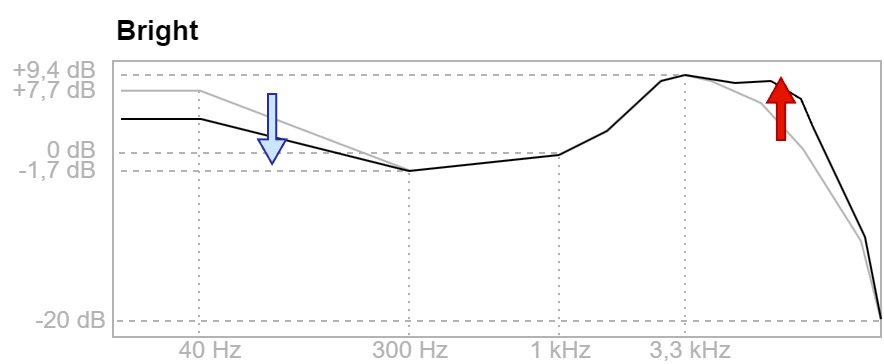
Bright:
This sound is ‘cold’ or ‘light’: there is less subbass and bass and more top. This is the Harman curve rotated counterclockwise.
V-shaped:
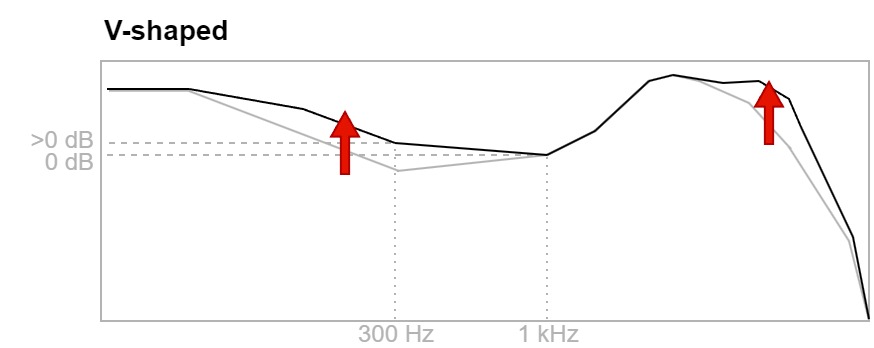
This is a popular V-shaped frequency response: there is more both bass and top.
Balanced:

Since the issue of defining what ‘neutral’ sound for earphones is has not been resolved so far, I decided to use the word ‘balanced’. There are the following options for the target curves here:
- IEF Neutral Target 2020 by Crinacle, to my ears, really sounds as the most neutral of anything I’ve tried;
- IEF Neutral Target 2023 by Crinacle differs from its predecessor by a very smooth rise on subbass up to 2.7 dB (there is also a difference at 1 to 3 kHz, but it’s only 2 dB);
- VSDF Target by Moondrop. It was obtained, as far as I understand, from converting the diffuse field curve from the B&K 5128 rig under the IEC711 standard. Plus, a small rise on the subbass has also been added.
All three curves are fundamentally similar. The difference lies in the magnitude of the rise at 3 kHz and the rate of the dip in upper frequencies.
Meta 2024:

This is the target curve obtained from diffuse field measurements on B&K 5128 (ΔJM1), to which subbass was added. It’s kind of the latest trend in targeted earphone tuning. The sound is pretty good and decent. Those willing to learn more are welcomed here.
Let me note an important thing: we’re talking about models above, and any models are a reduction of physical reality. There are no earphones that would correspond to any target curve up to one hundredth of a decibel a priori. We always have to do with fluctuations around some values. Moreover, there are cases when it is generally difficult to understand how to evaluate the sound of a model from graphs (see measurements of AFUL Explorer, Performer, etc.). Then you’ll have either to rely on my subjective assessment or to go and listen on your own.
To sum up, these are the definitions I will use below to describe the earphones’ sound.
6. Ranking per se
ATTENTION! THE CURRENT RATING IS HERE: https://boizoff.com/language/en/the-best-iems/
I put only the best, in my opinion, models on the list or, in other words, these are ‘top in-ears’. A list of everything I’ve tested, with brief comments on each model, will appear a bit later. I would like to note that all prices are stated at the time of the sale on November 11, 2024. Of course, the prices may change, but the ‘cheap-expensive’ ratio between them is likely to remain.
6.1 Category up to $5

KZ Dawn are the cheapest decent earphones in the world that I could find. They’re so cheap that you can’t even detach their cable from them. The sound is warm and basshead, but there is no ‘dip’ at about 10 kHz which is typical even for a higher price bracket, and, in general, high frequencies have no peaks or drops.

6.2 Category from $5 to $10

TRN MT5 have a very active top that may confuse some listeners, but the overall sound is quite good. There are also excellent compact metal enclosures and the worst cable I’ve ever seen.
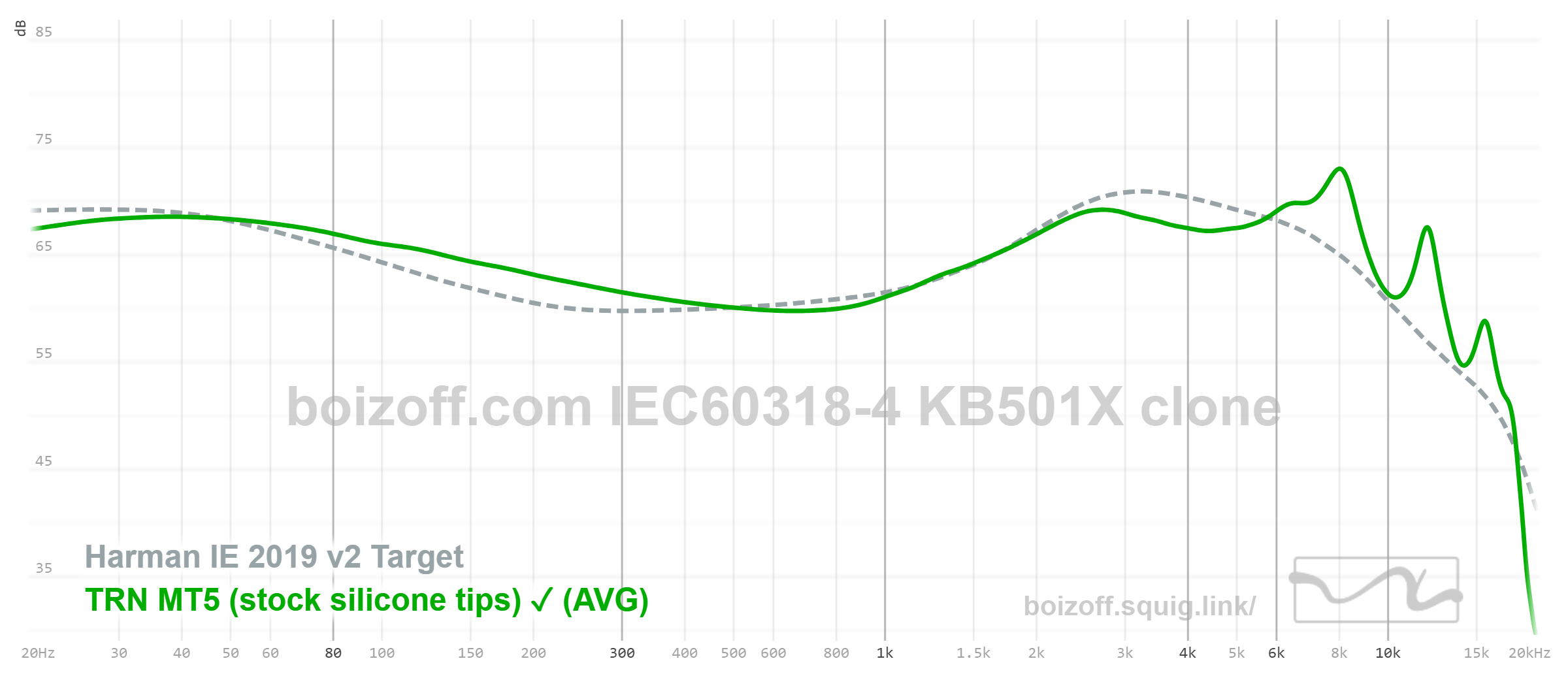
KZ EDC PRO have standard KZ low-end enclosures, a lot of bass and subbass, but also a relatively smooth ‘top’ and a moderate resonance at 11 kHz.

6.3 Category from $10 to $15
I have nothing here. I can’t recommend any earphones I’ve tested in this price tier.
6.4 Category from $15 to $25
Starting from here, we can already talk about serious sounding.

KBEAR KB01 have compact universal enclosures, smooth top, and slightly inflated bass. All the money was spent on the sound, and it’s outstanding. KB01 can be easily worn under a tight hat in winter, and you can even sleep in them.

Truthear Gate are a case when the manufacturer managed to cram lukewarm, but still close to neutral sound delivery into funny transparent enclosures. The sound ducts are short, so you may need longer eartips. I had two samples – the measurements for both are exactly the same, which inspires hope that there is a minimum difference between the specimens.

Celest (Kinera) Wyvern Abyss are slightly bassier than Harman requires, but there is no peak at 11 kHz, while 6 kHz never torments the user’s hearing. They have beautiful, textured enclosures and a Pro version with a wired microphone, even with a wind shield. This is a bounty for a novice office audiophile or a computer game lover.

Tangzu Wan’es SG Studio Edition have a very neatly tuned, wide and light sound and cunningly shaped ‘mature’ enclosures.

MOONDROP Quarks 2 have a fixed cable and a Type-C connector (and microphone), are not much to look at, but provide the sound that is phenomenally smooth at ‘tops’, as well as the overall balance of the sound delivery, which is perceived as neutral by ear. They are designed to be worn with their wire down, but you can habitually throw it behind your ear. And don’t let the mesh on the back of the enclosure fool you: the earphones are closed-back. You might also need longer eartips.

6.5 Category from $25 to $50

Celest (Kinera) Pandamon 2.0 are the cutest-looking round earphones, which sound emphasizes the middle and bass, but in a very careful way, so I tend to characterize their sound delivery as warm-neutral. The shape of the enclosures is universal. At the sale, a micro DAC (a round one, too) was given as a present.

Kefine KLEAN (silver filter): with a black filter, the sound gets an unpleasant shrilly hue, but the silver one makes the sound delivery comfortable and ‘warm’. This is one of the best implementations of such tuning for chump change. The enclosures are metal, the ergonomics is universal. Two specimens that I have basically ensure the same measurements.

CCA Rhapsody (with tuning 1001): of all the 16 tuning options provided by 4 two-way switches, I recommend 1001. The frequency response becomes close to the Harman target curve, with the exception of bass – there is more of it — and a large rise at 8 kHz. You can read more in my article.

6.6 Category from $50 to $70

Simgot EA500 LM (golden sound ducts with red rings): it doesn’t matter if you listen to Mozart, Placebo, Manu Chao or Vesta, as EA500 LM make Rammstein out of any music. Anything sounds assertive and aggressive, sonorous and percussive. The only thing that EA500 LM can’t do is to let a listener get some rest.

TRUTHEAR×Crinacle ZERO: RED: I wrote a review of them, so , in a nutshell, they are fucking awesome. The only embarrassing thing is the difference between the specimens: my practice shows that it can be very large.

6.7 Category from $70 to $100

Shanling TINO have very comfortable small enclosures with beautiful plates and a glamorous cable with changeable connectors. The sound emphasizes middle and upper frequencies, and only the few manage to implement this smoothly. But Shanling did it in their TINO model. Don’t be afraid of these peaks on the graph — it’s better to listen to them with your own ears.

Simgot EM6L: the frequency response of these earphones seems to be completely shifted to the right in relation to the Harman curve. Usually such experiments end up badly: the sound delivery turns out to be tonally unreliable, that is, you listen to music, but everything sounds somehow… wrong. EM6L don’t have this problem: the sound has just become somewhat ‘thinner’ and ‘lighter’ than usual, which leads to a feeling of balanced sound delivery. I’m not a fan of this model, but it doesn’t make these earphones worse. They’re great.

Rose Technics Star City 5 Pro is my personal, special, secret love. These earphones deserve much more attention from reviewers than they actually have. They have very versatile enclosures of interesting design, tailored to a deep fit, and a micro DAC included (!). Their sound is neutral to warm. There is no pronounced clubbing subbass or bright ‘top’ — it’s all about balance and a clear middle. You can find two versions of them online: an old one for MMCX and a new one for 2-pin.

Truthear HEXA are the earphones that are practically neutral to my ear. They have very versatile enclosures (though they never look this way) and a very pleasant, natural ‘middle’. Read more in my article.
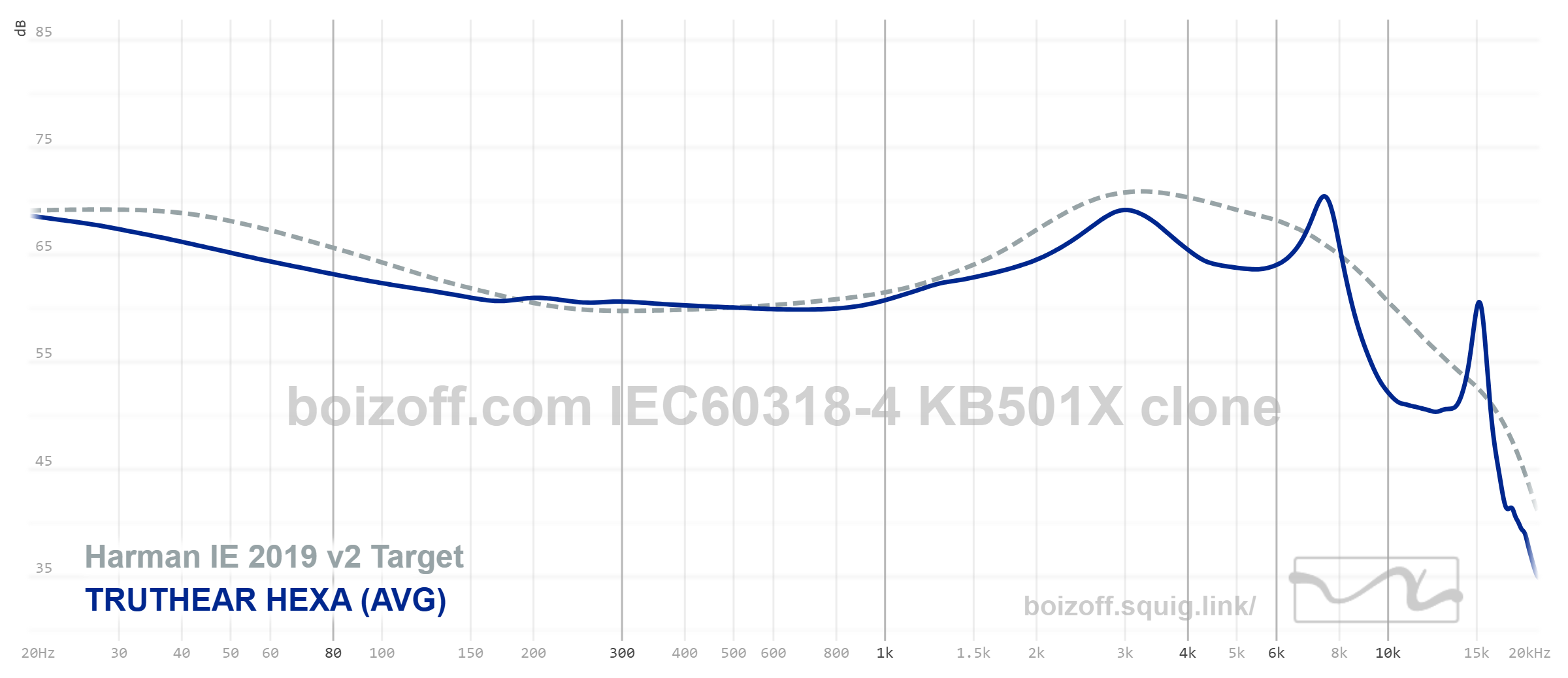
6.8 Category from $100 to $150

Truthear NOVA are a flagship product of Truthear. NOVA play incredibly well – balanced, wide, etc. It’s hard to find fault with their sound, even if you want to, but you can complain about the quirky shape of their large enclosures and the earholders scratching your skin (because they are too short).

6.9 Category from $150 to $200

Binary Acoustics × Gizaudio Chopin are some of the best V-shaped earphones above all price categories. I can’t consider their mediocre appearance and idiotic box as real disadvantages, but a perfectly balanced, really ‘evil’ sound, extended high frequencies, and small enclosures that are universal in terms of their fit are absolute advantages. Read more in my review.

Kiwi Ears Quintet are very carefully tuned earphones for those who considers Harman sound delivery to be a little shrilly, who want more warmth in the sound, but without losing all other sound qualities.

6.10 Category from $200 to $250

PULA ANVIL114 are those ‘new earphones with a bone conduction driver’. They’re not the first ones, though. There are very large enclosures that noticeably resonate after flicking on them with a nail, as if there is a spring inside. The sound is comfortable, up there with Star City 5 Pro (see sec. 6.7), warm, but with a pronounced ‘top’. Compared to the neutral curve, ANVIL114 have more bass and ‘top’ at about 8 kHz. Compared to the Harman one, they’re short of subbass and mid frequencies. By ear, this sound delivery is perceived as V-shaped and kind of warm, but with pronounced upper frequencies and a wide sound stage. And, well, apparently due to this bone conduction driver, ANVIL114 can sound very low. VERY. LOW. Here you can feel what 10 Hz is like. It’s when you go deaf 10 times per second. Some earphones can’t do anything like this at all, actually. The kit also includes a glamorous case, a glamorous cable and 12 pairs of eartips. My compliments!

6.11 Category from $250 to $300
Again, I have nothing here. I can’t say that Performer 5+2, Hype 2, or Concerto are good earphones, far less the best ones.
6.12 Category from $300 to $500

Moondrop Variations are the earphones, about which I can only say that they sound ‘right’. Everything is good in their sound, everything is correct, everything is balanced, and there are exactly as many frequencies as necessary. Of all the in-ear models that I’ve tested, I personally like Variations most of all.

6.13 Category from $500 to $700

Hisenior Mega5-EST are warmish-neutral earphones tuned in the latest fashion. They never disturb your ear and are perfect for competitive games. The only thing that failed just a little bit is the attachment of cable connectors. The fit is somewhat controversial, too. I wrote a big review about them, so I don’t want to repeat myself.

7. The whole ranking in one picture
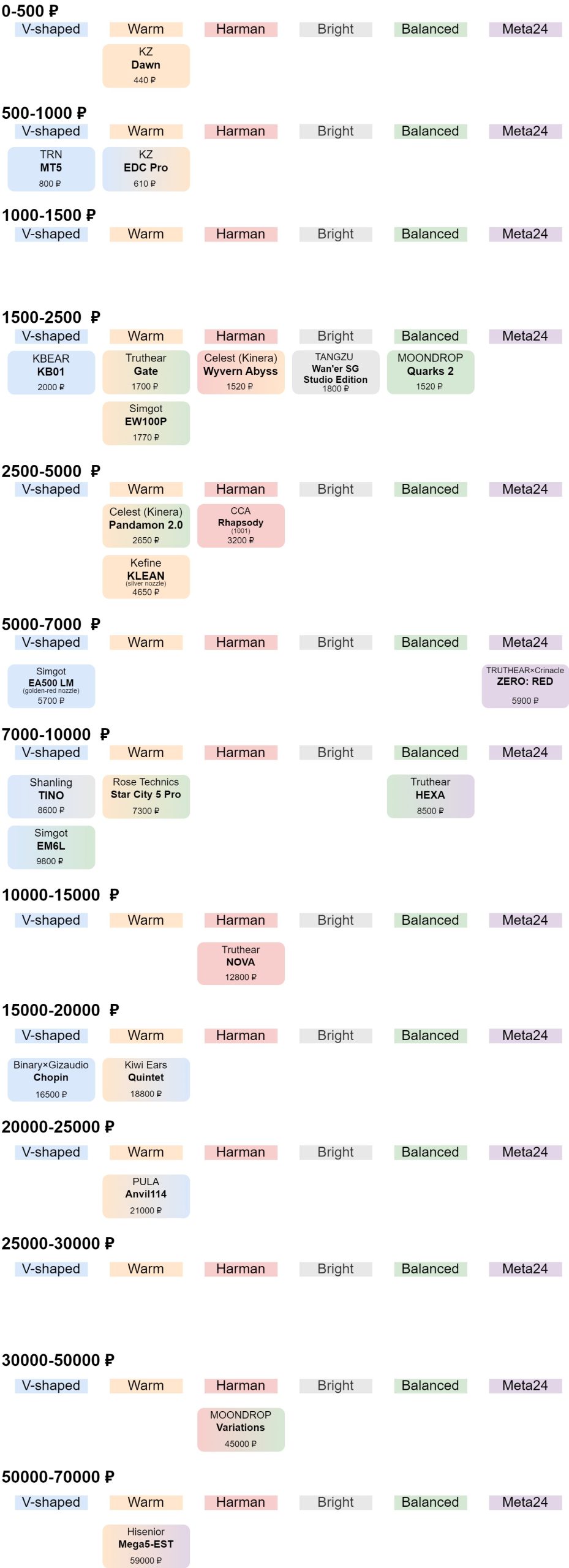
8. What’s next?
The next steps are pretty simple.
- Out of the entire heap of the earphones that I currently have on hand, I’ll keep only those listed above so that I could compare those new models that will come into my hands in the future directly with them. The rest will be sold.
- The ranking will be gradually added to and updated. At the moment, 10 more pairs of earphones are coming to me.
- A little later, there will be a page containing a list of the earphones that are not on this list with brief comments on each model. There will be some info about AFUL Performer 5+2, Moondrop Concerto, CKLVX CK-D62, CLAVELON DELTA, INTUARURA Reference 2019, and so on and so forth. I’ve bought and carefully tested all of them, too.
And now I’m taking my leave.
9. FAQ by Captain Obvious
Q: Why don’t I see XXX earphones on the ranking list?
A: Possible reasons are as follows:
- I could reject them in the selection process, judging from their measurements (here’s a funny example),
- I could test and measure them, but they didn’t become the best in any category,
- I don’t know anything about them. So it goes.
Q: I don’t like your ranking! It’s wrong, and I don’t agree!
A: Go ahead and make up your own. There’s no need to share that you’re not happy with my blog in my blog.
Q: You wrote that XXX headphones are warm, but they are actually cold!
A: Not “actually”, but “it seems to you that”. And I wrote about what seemed to me and proved it with my measurements. When in doubt, see the previous question and the answer to it.
Q: I poke at the measurements on your squig, and there is an error…
A: Please report where you’ve found the error, and I’ll fix it.
Q: May I send you XXX earphones for measurements?
A: If I don’t have their measurements, you are highly encouraged to do so. Feel free to send me an email so that we could arrange all the details. I’m particularly interested in the following models:
- Tanchjim Origin;
- Softears Studio 4;
Letshouer S12;- Sennheiser IE600;
Simgot Supermix 4;- Moondrop Dusk (DSP);
- AFUL Cantor;
- THIEAUDIO Monarch MKII;
- TRI i3 MK3;
- Xenns Mangrid Tea Pro 2024;
KiiBOOM Evoke.


